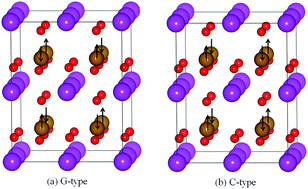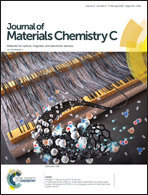Orbital controlled band gap engineering of tetragonal BiFeO3 for optoelectronic applications†
Abstract
Bismuth ferrite BiFeO3 (BFO) is an important ferroelectric material for thin-film optoelectronic sensing and potential photovoltaic applications. Its relatively large band gap, however, limits the conversion efficiency of BFO absorber-based PV devices. In this study, based on density functional theory calculations we demonstrate that with well-designed Fe-site elemental substitution, tetragonal BFO can exhibit a much lower fundamental band gap than that of conventional rhombohedral BFO without forming in-gap electronic states and unravelling the underlying mechanisms. Cation atomic size, electronegativity, and crystallographic symmetry are evidenced as critical parameters to tailor the metal 3d–oxygen 2p orbital interactions and thus intrinsically modify the electronic structure, particularly, the shape and character of the valence and conduction band edges. With the reduced band gap, improved mobility, and uncompromised ferroelectric and magnetic ground states, the present results provide a new strategy of designing high symmetry BFO for efficient optoelectronic applications.



 Please wait while we load your content...
Please wait while we load your content...